Isometric Exercises
What exactly is an Isometric exercise?
An Isometric exercise is one in which a muscle contracts in a static position with no apparent movement in the joint. The word “isometric” originates from the Greek words isos, which means “equal,” while -metria, which means “measuring.” It means that isometric exercises don’t change the length of the muscle or the angle of the joint, but you can vary the strength of your contractions.
Exercises that recruit muscles and exert tension without actually any contraction of the muscle (eccentric contraction) are referred to as isometric training. In an isometric constriction, your muscle is working, yet all at once it’s not evolving size.
Holding your body in a certain position for a predetermined amount of time is the primary goal of this form of exercise, which does not involve any movement.
This kind of resistance can be provided by weighted exercise equipment, holding an object, or gravity. Isometric exercises are mainly useful for those who have not allowed movement due to injury, have limited space, recovering from an injury, or are simply in need of a variation from their exercise program.
Isometric exercises are frequently incorporated into rehabilitation programs due to their ability to increase muscle tension while minimizing joint and muscle movement. Muscles and tendons that have been injured can be strengthened and maintained to prevent further damage.
All things being equal, except if your actual coach has prompted you in any case, these activities ought to just be utilized as an enhancement to a more powerful activity program because of the restricted solid constrictions they include. In comparison, there is no joint movement when a muscle contracts isometrically, it fires (or stimulates with force and tension).
As such, the joint is stationary, the muscles don’t extend, and the movement doesn’t occur.
During this type of muscle contraction, the muscle fibers continue to work despite the fact that there is neither joint movement nor a change in the length of the muscle fibers.
As opposed to concentric muscle compression, there is no development at the joints while the muscles are as yet being worked.
An isometric muscle contraction—also known as a muscle fiber activation—is one of the three distinct types of muscle contractions.
These occur when the brain sends a nerve signal to activate a muscle fiber or group of muscle fibers, resulting in an increase in muscle tension, as is the case during weight training. The actual contraction takes place in the myofibrils, which are the human body’s muscles and are composed of thousands of smaller structures known as muscle fiber bundles.
The bundles of muscle fibers that make up a human body are made up of thousands of smaller structures called myofibrils, which are where the actual contraction takes place.
Mechanism of the isometrics:
An action that maintains the visible angle of the joints is called an isometric action. The objective of a mechanism of isometric exercise is to hold a body position; this may likewise be called an isometric hold.
The goal of an isometric exercise is to either push or pull against another part, which also pulls back with the same force, or try to move a static object. As a result of this, completing an isometric exercise may also be referred to as an isometric press or pull.
Unweighted isometrics: The exerciser only applies resistance to themselves during unweighted isometrics. For instance, standing firm in a squatted situation, or squeezing the centers of the hands inverse of one another. In which one presses against itself, this is likewise shown as self-opposition or Dynamic Pressure preparation.
Weighted isometrics: involve pushing or pulling a static structure or weight and holding extra weight. such as the barbell can be held in a static position during a bench press exercise and neither pushed nor allowed to move. Alternately, a person can attempt to pull an immovably fixed bar upwards in a mid-thigh pull set-up.
Dynamic leg movement and isometric barbell holding are two forms of isometric exercise that this lifter will perform after completing his lift. Isometric training is typically incorporated into a broader training plan and rarely used on its own. For example, an isometric board might be integrated into a plyometrics system.
In addition, when an individual performs a dynamic movement, isometric work of supporting muscle groups can occur. For instance, in the event that individuals squat while holding a hand weight before their chest, then, at that point, their arm activity will be somewhat isometric, while their leg activity will be dynamic.
In weightlifting, such a connection exists between an isometric hold and a dynamic movement: members normally hold a free weight above with straight arms while fixing their legs when they stand up from a squat position.
Because of this, lifting the weight is primarily performed by the legs.
However, it is uncommon to use a pure isometric action in most sports-related situations. For instance, when skiing, the skier always stays in a crouching position.
While this might be viewed as an isometric hold, there is additionally a measure of dynamic development as the skier modifies how profound the hunker is during their movement.
Even though it is not solely isometric, isometrics can be said to be a part of skiing as a whole and to support it.
In weight training, there are often parts of the workout that are harder to do than others. A sticking point is when the exerciser has a tendency to fail at this point. At this point, the exerciser’s action may be strengthened by incorporating an isometric hold. For example, a staying point in a weighty back squat is typically the most reduced position came.
To improve the lifter’s capacity to hold the weight in this position, an isometric hold can be used. This can help them lift the weight more easily from this position over the course of training, removing the sticking point.
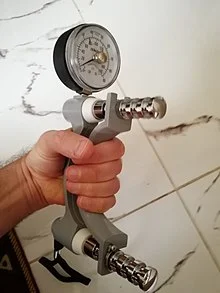
Instruments for measuring force during isometric movements:
The subject is required to stand on a force measurement plate for this. Their bodyweight and their descending solid power push down on the plate which enlists a perusing. Most of the time, the subject’s downward muscular force comes from pressing or pulling against something, which causes them to press downward. For instance, the subject performs a mid-thigh pull exercise by pulling upwards on a fixed barbell that is positioned around their mid-thigh. They push down with their feet as a result of this action, putting pressure on the plate in addition to their body weight.
Dynamometer: A dynamometer is a gadget that includes two handles being pushed, pulled, or crushed together, or pushed or pulled separately, to enroll a perusing. As the handles are normally incredibly solid there is next to no development and the activity remains overwhelmingly isometric in nature.
For instance, a dynamometer can be utilized to gauge grasp strength: The participant tries to squeeze its two handles together while holding it in one hand; This causes the gauge to record a force measurement.
Electromyograph: Utilizing electrodes that are either positioned on the muscle in the form of pads or inserted into the muscle in the form of needles, an electromyograph measures the levels of muscle activation. It can measure the level of muscle activation during isometric holds, presses, and pulls. Commonly there are areas of strength between the mechanical estimation of applied force and the estimation of muscle enactment by electromyography.
How to get the most out of Isometric exercises?
Center around a big structure. Pay attention to your posture in order to effectively target your muscles and avoid injury.
Consciously tighten your muscles. Pay special attention to how your muscles are contracting as you do the exercise. This will help ensure proper form and improve muscle activation, allowing for greater gains in endurance and strength.
Breathe. It’s generally expected to neglect to inhale during isometric activity. Continually ensure that you are breathing throughout the exercise.
Don’t go overboard. It very well might be an urge to stand firm on a footing however long you can. Be that as it may, this can be extremely burdening on the body and may prompt injury. Instead, proper form should come first.
If you don’t feel like doing an exercise, it’s probably best to skip it. Assuming that you’re suffering from a physical issue, consistently pay attention to the guidance from your actual advisor, specialist, mentor, or other medical care proficient.
When is Isometric exercise appropriate?
While isometric muscular contractions can be used at any time during your rehabilitation or home exercise program, there are times when they are preferred. It could include:
After surgery, when your muscle is unable to contract sufficiently to move the surrounding joint.
To assist in increasing neuromuscular input to a particular muscle.
When other forms of exercise are dangerous or impossible due to weakness.
Before trying isometrics, ask your doctor or physical therapist if they should be part of your rehabilitation program.
How to Perform Isometric Exercises?
To perform isometric exercises, all you need is a stable object to push against. For instance, to strengthen your shoulder muscles isometrically, stand next to a wall and attempt to lift one arm to the side. Allow your hand to press against the wall so that your shoulder joint is not moved.
When you are pushing against the wall, hold the withdrawal for 5 to 6 seconds, and afterward leisurely deliver the constriction. One set of shoulder muscles isometric exercises has been completed if you complete six to ten repetitions.
Isometric exercises can also be done with tubing or elastic resistance bands. This can be accomplished by moving your body away from the anchor point without moving your joint while holding the tubing in a particular position. The elastic tubing’s increased resistance will cause your muscles to contract, preventing you from moving your joint. Your actual advisor can assist you with acquiring versatile groups or tubing and tell you the best way to perform isometric activities with the groups.
Examples of Isometric exercises:
If you’re looking to add some isometric exercises to your routine, give these exercises a try.
1. Wall sit
Wall sits are designed to strengthen your quadriceps, which are the muscles in your thighs.
Quadriceps, hamstrings, and glutes each worked.
Steps:
Leaning your back against a solid wall, stand about two feet away from it.
Your knees should form a 90-degree angle as you flex them and lower your bottom. Your body should be in a position similar to your chair-sitting posture.
Hold this posture for at least 15 seconds.
Maintain contact with the wall by keeping your hips, shoulders, and knees over your ankles.
Do two or three rounds.
You’ll notice that your thighs are getting tighter and more tired as you attempt to hold this position.
Try switching between attempting to reduce your weight through.
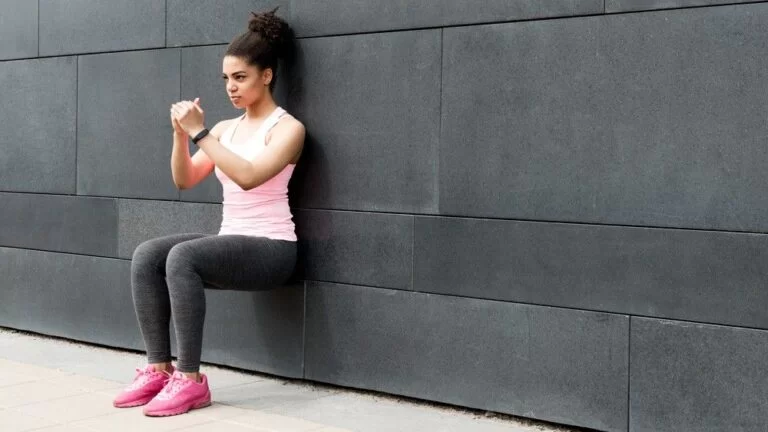
2. Hold the high plank
The high plank hold is a useful exercise for working out a variety of body parts. A yoga mat is optional but recommended.
Abs, quadriceps, glutes, arm, chest, and shoulder muscles were all worked.
Steps
Start by doing a pushup while on your knees with your arms shoulder-distance apart. To raise your body into a high plank position, press your hands into the ground, straighten your knees, and push down into the balls of your feet. Your body should appear to be in the upward pushup position. Make sure your core is engaged, your legs are straight, and your hands and shoulders are in alignment. Hold this position for 20 to 60 seconds, or for however long you can keep your form intact. Once more, repeat a second time.
3. Side plank
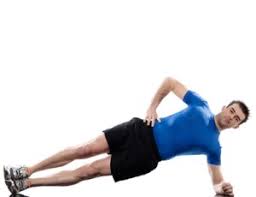
The side plank is a great exercise for your obliques, which are muscles on either side of your middle.
A yoga mat is optional but recommended.
Obliques, spinal stabilizers, quadriceps, glutes, serratus anterior, shoulder stabilizers, and hip abductors were the muscles that worked.
Stack your hips, knees, and feet while lying on your left side with your legs straight. Put your forearm on the floor beneath your shoulder while bending your left elbow.
Lift your torso and hips off the ground by driving your left forearm into the ground. Maintain a tight core and check that your body is moving in a straight line from head to heel.
Keep your right arm by your side or extend it straight up in the air.
Keep your body in this position for ten or more seconds. then change sides.
If you’d prefer.
4. Low squat
Technically, you could keep your body still throughout the contraction to turn most exercises into isometric exercises.
The squat serves as an illustration of what we mean.
The quadriceps, glutes, and hamstrings were worked.
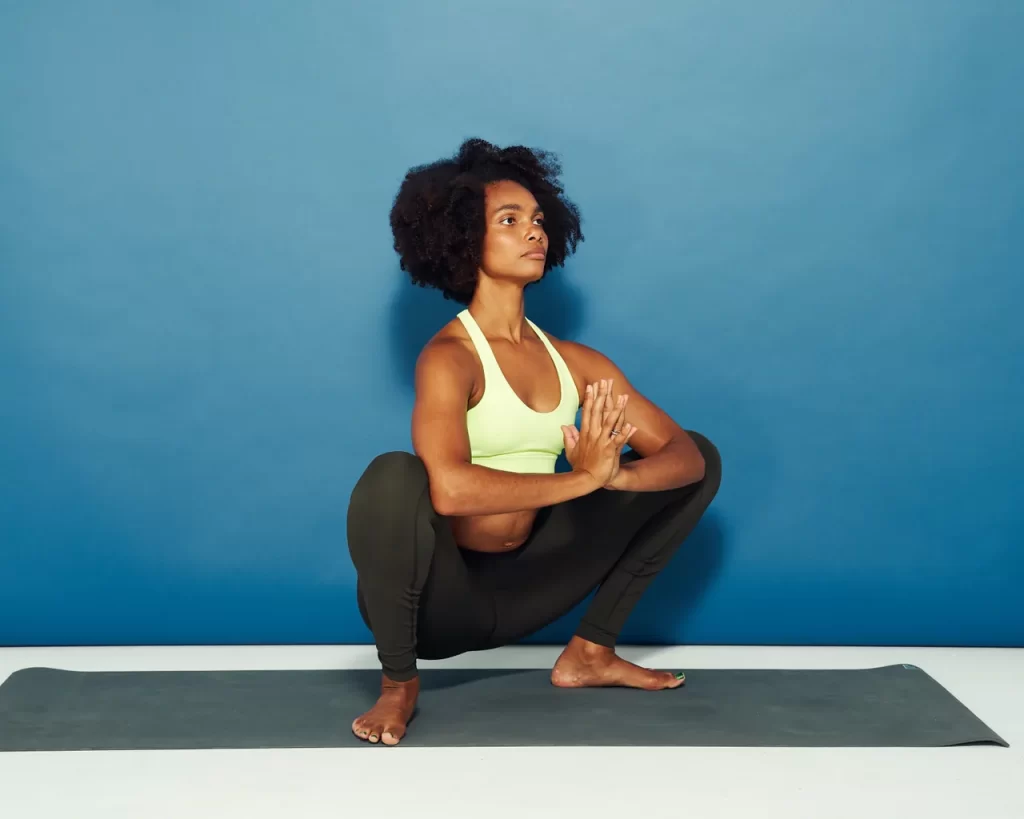
Your feet should be slightly wider than hip-width apart as you stand. If it’s more comfortable, you can stand with your hands out in front of you or on your hips with your toes slightly pointed out.
Bend your knees and slowly push your hips back into a sitting position. Do not force your knees forward.
Lower yourself further until your butt is just above knee level. If you are unable to go any lower, position yourself so that your thighs are parallel to the ground. Keep your spine long, heels down, and your feet firmly planted. long without rounding forward.
Stay in this position for a minimum of 10–30 seconds. Then, return to the starting position.
Perform 3–5 rounds.
5. Overhead hold:
Performing overhead holds tests your shoulder girdle’s muscular endurance.
Required equipment: Start with a plate, dumbbell, or kettlebell that weighs 5 to 10 pounds, or even just two soup cans. Increment the load depending on the situation.)
Muscles worked mainly triceps, core, upper trapezius, and shoulder girdle muscles
Extend your arms above your head and maintain a steady weight. Contract your core muscles at all times.
Keep your arms fully extended and parallel to your shoulders at all times. Twisting your arms will draw in various muscles (your biceps and rear arm muscles).
Maintain the weight above your head for 20 to 30 seconds at a time. However, if you are concerned that you might lose weight, stop before this.
Do two to three rounds.
Standing on one leg while holding the weight increases the difficulty.
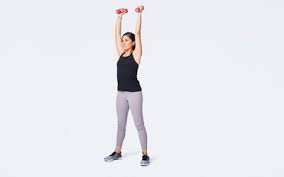
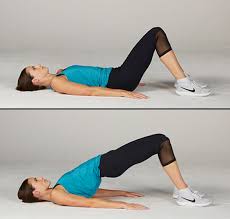
6. Glutes bridge
This exercise will immediately turn into a #1 for anybody hoping to work on the strength of their posterior.
Required equipment: Optional yoga mat
Muscles worked: core, glutes, and hamstrings:
Steps:
Take a supine position on a soft mat with your knees bent and arms at your sides. Your heels ought to be 12-16 creeps from your butt.
Press into your heels, support your center, and move your pelvis upwards by crushing your glutes. During this movement, make sure that your ribs do not flare. Keep your feet flat on the floor, your abdominals engaged, and your tailbone slightly tucked in.
Your hamstrings and glutes will begin to feel tired. Fight the temptation to allow your hips to sink or your back curve.
Complete 2-3 rounds of a 30-second hold.
7. V-sit
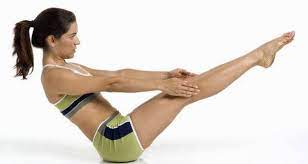
The V-sit assists you with chipping away at your center dependability while likewise creating center strength.
Required equipment: Optional yoga mat
Muscles worked: abdominals and hip flexors
Steps
Sit on your back, knees bent, feet flat on the ground.
Make a “V” shape with your body and legs while engaging your core and raising your feet off the ground. To make the exercise easier, you can keep your arms by your side or reach them straight overhead to make it harder. Avoid rounding your shoulders and maintaining a straight back. During the exercise, continue to breathe.
If keeping a straight-leg position makes it hard to keep your spine long or makes your hip flexors stay at work past 40 hours, twist your knees somewhat to extend your back and draw in the abs more.
Maintain proper form while holding this position for at least 15 seconds.
Perform 2-3 rounds.
8. Calf raise and hold:
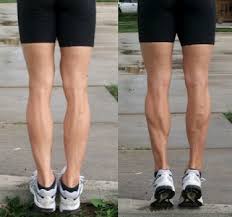
Despite their importance for maintaining strength, calves are frequently overlooked. In this exercise, you will hold the top position of the calf raise instead of moving up and down like you would with normal calf raises.
Hardware required: Optional support wall
Worked muscles: calves (gastrocnemius, soleus).
Stand with your feet hip-distance separated. For support, you might want to stand about two feet from a wall.
Push into the balls of your feet and raise your heels off the ground while keeping your hands on your hips or resting lightly against a wall for support.
Keep this position for between 20 and 30 seconds.
Perform 2-3 rounds.
Try this on one foot for extra difficulty. Change sides then.
The Benefits of Isometric Exercises:
These are some benefits of isometric exercise…..
- Lowers Blood Pressure
- Saves patient’s time
- Helps in Weight Loss
- Reduces whole-body pain
- Increases range of Motion
- Helps in getting stronger and bigger muscle
- Improves stamina
The disadvantages of isometric exercise:
Isometric exercise is a type of strength training that involves keeping a static posture for an extended amount of time. While it
can be an excellent approach to increasing muscular strength and endurance, but it does have limitations.
- Limited range of motion: Isometric exercises contracts the muscles in a static position, which may limit their range of motion.
might make doing a few tasks or movements that demand additional flexibility difficult.
- Plateau effect: The body can adapt to the tension exerted on it during isometric workouts over time, resulting in a plateau
effect in which development slows or finishes completely. To maintain results, it may be essential to change up the workouts or add more resistance.
- Time-consuming: Isometric workouts frequently involve maintaining a position for an extended period of time, which can be
time-consuming and inconvenient for people with busy lifestyles.
- Not suitable for all fitness levels: Isometric exercises might be difficult for newcomers or people with restricted mobility to exercise efficiently since they demand a particular level of strength and endurance.
- injury risk: As previously stated, there is a danger of injury with isometric workouts, particularly if sufficient form and
breathing methods are not maintained.
Risks associated with Isometric exercises:
Most of the time, isometric exercises are less used on major muscle groups than many dynamic movements. In any case, in spite of the fact that they can be more secure, isometric activities might cause or worsen existing wounds.
Injuries can also occur when isometric exercises are performed improperly. For instance, performing a plank improperly can increase back tension and increase the risk of injury.
If any pain or discomfort is noticed during performing an isometric exercise, they should stop immediately.
- The temporary rise in blood pressure: Isometric workouts might result in a brief rise in blood pressure, which can be harmful to people with heart disease or excessive blood pressure.
- Muscle strain: Remaining in a still position for a long time can strain the muscles, resulting in discomfort, or any kind of injury.
- Joint pain: Holding a position during isometric workouts can lead to occurring of strain on the joints, resulting in pain or discomfort.
- Holding your breath during isometric activities can result in a drop in oxygen levels, which can produce dizziness or lightheadedness.
Conclusion:
In a nutshell, isometric exercises help in improving muscle function without any visible movements of the muscles.
People who have a limited range of motion, such as a result of an injury or medical condition, can use them.
Integrating isometric activities into a current workout routine can further develop muscle growth.
FAQ
What is an isometric exercise?
Exercise that involves the static contraction of a muscle without a noticeable difference in the angle of the joint is known as an isometric exercise. The word “isometric” is a combination of the Greek terms for workouts in which the angle of the joint and the length of the muscle remain constant.
Why choose to do isometric exercise?
There are some exercises the patient is not able to perform due to movements, thus the isometric exercises help in improving muscle strength without any visible movement.
Which is better, isometric or isotonic?
Isotonic refers to “same tension” (the weight on your muscles does not change over time). It’s also important to understand that you are capable of doing specific isotonic or isometric movements. Based on your objectives. Thus according to your body, it is suggested which exercise is better.
Why is the squat isometric?
For example, during a squat, the muscles of the hip adductor and abductor contract isometrically, applying equal force on the
knee.
While other muscles move the joint, these muscles limit motion and maintain stability in the frontal and transverse planes.
The sagittal plane’s hip, knee, and ankle.
What are the benefits of isometric exercise?
The benefits of Isometric Exercise:
reduces blood pressure, helps with weight loss, saves time, and reduces stress.
Improve range of motion, lessen back pain, and lessen overall discomfort.
Gaining muscle strength and muscle bulk
What is an example of an isometric exercise?
Following are examples of isometric exercises:
Planks
Glutes bridge
Bridging
Low squat

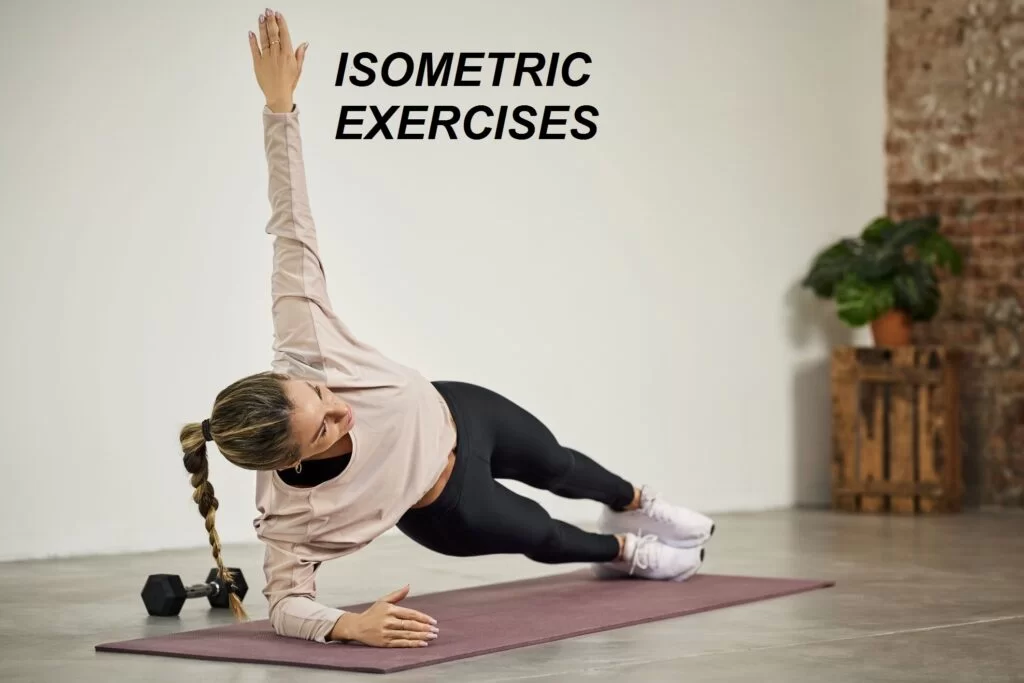
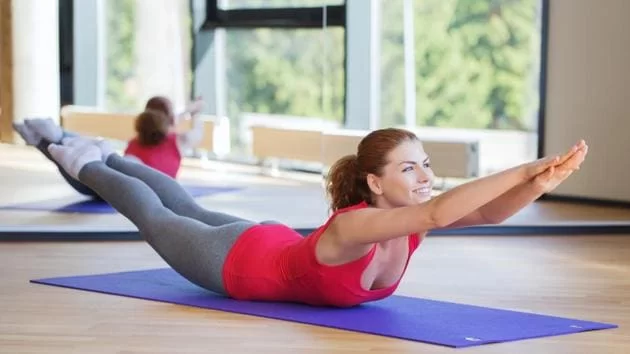
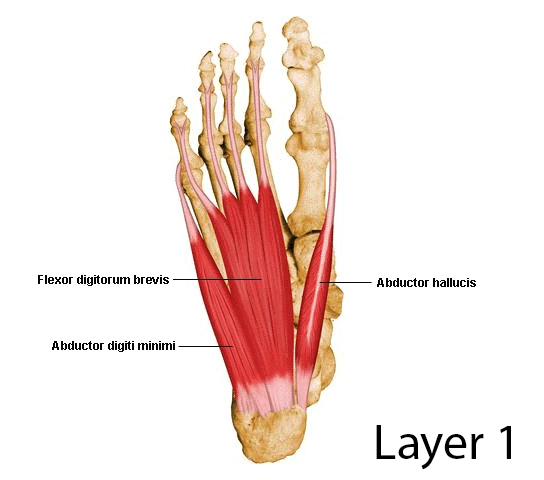

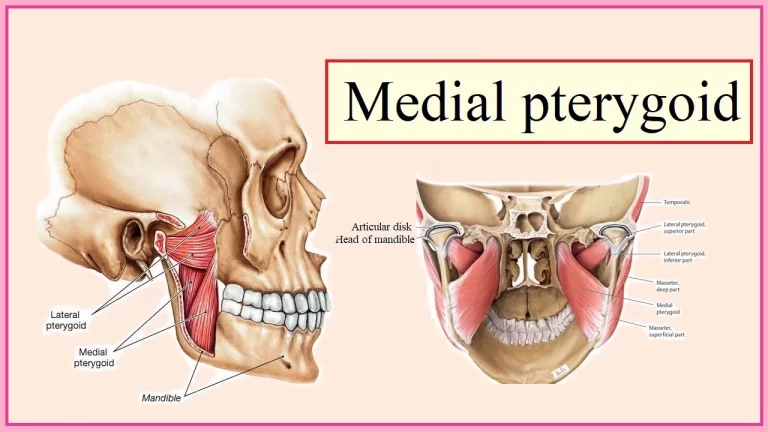
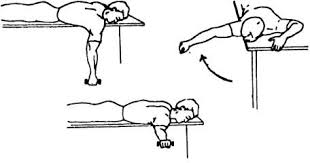

4 Comments